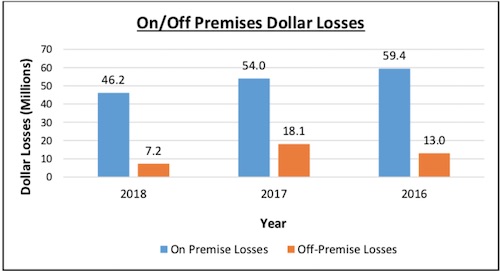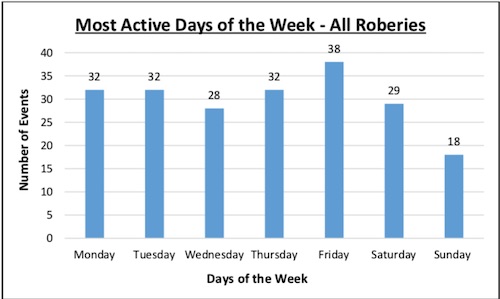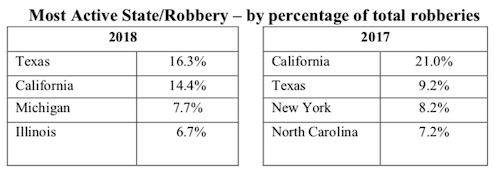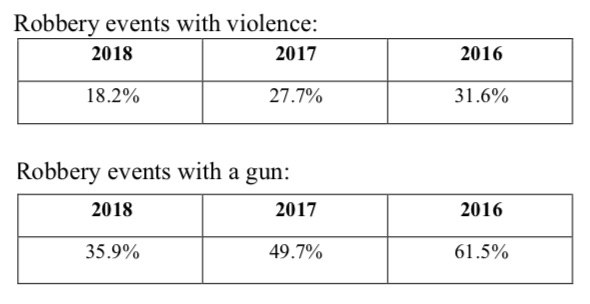Articles and News
Jewelry Crime Down More than 25% In 2018; JSA Credits Law Enforcement, Intelligence Sharing | October 02, 2019 (0 comments)

New York, NY—Dollar losses from crimes against U.S. jewelry firms decreased 25.9% from 2017 to 2018, says the Jewelers Security Alliance in a new report. Dollar losses declined from $72.1 million in 2017 to $53.4 million in 2018; a figure which, when adjusted for inflation, represents a remarkable 75% decline since 1999.
The findings are part of JSA’s 2018 Annual Crime Report, a 22-page document covering 1,441 crimes committed against the jewelry industry in the U.S. The report summarizes when, where and how those crimes occurred.
JSA president John Kennedy credits solid partnerships with law enforcement agencies and intelligence sharing, noting that both are the direct result of support from the jewelry industry.
“Due to support from the industry, JSA has been able to add substantial resources to its crime analysis and intelligence capability, its reward program, and its crime information-sharing effectiveness. In addition to informing the industry with frequent Crime Alerts, JSA shares detailed intelligence information regarding jewelry gangs, suspects, and crime patterns with the FBI and other law enforcement agencies, both here and abroad, on a daily basis. JSA receives countless messages of thanks from law enforcement personnel for information that has helped in their investigations, and from jewelers who have prevented crimes.”

Chart: JSA
The full report has both ups and downs in the fight against jewelry crime. Other highlighted statistics from the report include:
- The total number of crimes increased from 1,394 in 2017 to 1,441 in 2018.
- Dollar losses from Off-Premises Crimes (such as against traveling salespersons or losses at shows) decreased from $18.1 million in 2017 to $7.2 million in 2018, a record low since at least the 1980s.
- Smash-and-grab robberies increased from 71 in 2017 to 129 in 2018, an increase of 81.6%—but arrests of smash and grab jewelry criminals also increased from 28 in 2017 to 65 in 2018. Smash-and-grabs occurred most often in mall locations.
- Total number of robberies—all kinds—increased 7.2%, from 195 in 2017 to 209 in 2018. But on an encouraging note, the number of violent robberies both with and without a gun declined steadily over the past three years.
- One jeweler was killed during a robbery in 2018, tied for a record low since 1980, compared to five in 2017. The number of jewelers non-fatally shot also declined from five in 2017 to three in 2018.
- Jewelers in mall locations experienced 66.4% of all on-premises crimes in 2018, compared to the crimes at all locations such as strip centers, downtown locations or standalone stores.
- Grab-and-runs were the most frequently reported crime, with 641 cases.

Chart: JSA
Texas and California remain the two states with the most robberies by percentage of total. But the two flipped position: in 2017, California led the way with 21% of all robberies occurring in the state. In 2018, that dubious honor went to Texas, with 16.3% of all robberies happening in the state, a 7.1% jump from the 9.2% of all robberies it had in 2017, catapulting it into first place over California in 2018. There, robberies as a percentage of the total declined almost 7% year on year. Michigan and Illinois came in third and fourth, respectively, in 2018, compared to New York and North Carolina in those positions a year earlier.

Charts: JSA
Kennedy said, “A big advance in JSA’s work, and an important element in the reduction in crime, has been JSA’s growing ability to map crime patterns and target hot spots, and to work with multiple law enforcement agencies spanning many states and jurisdictions to coordinate information sharing on suspects and gangs.
“When JSA sees a crime pattern emerging, JSA is able to be all over it. Information goes out to JSA’s members, to the broader industry, to the trade media, and a dialogue is opened with the relevant FBI or other law enforcement personnel, including agencies in other countries.”
A very bright spot in the 2018 report is how few off-premises losses there were (i.e. traveling salespeople and trunk show personnel.) In 1999, the U.S. diamond, jewelry, and watch industry experienced 323 of these crimes; in 2018 JSA received just 34 reports of same. Kennedy credits this to thededicated interest by law enforcement, particularly the FBI, in cooperation with local law enforcement agencies; the greatly reduced number of traveling jewelry salespeople on the road due to changing methods of jewelry distribution and sales; and greater education and information sharing by jewelry firms and police.

Charts: JSA
JSA urges all jewelry firm owners and their employees to spend time reading and discussing the Report. Knowing the information in it—especially key day and time patterns for different kinds of crimes—and examining the risk a jewelry business faces, can help keep that business safe from crime.







